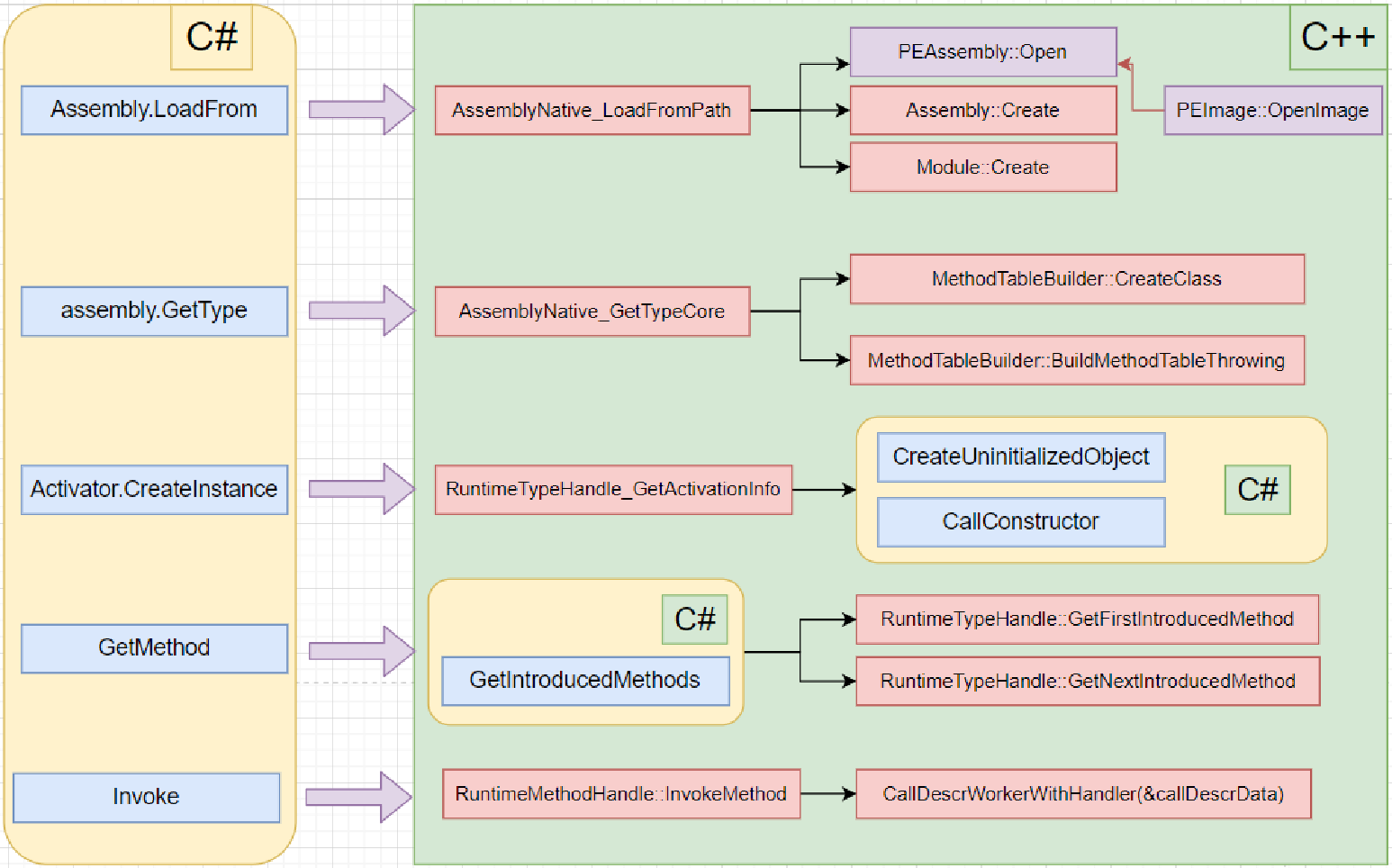.NET Core 反射(Reflection)底层原理浅谈
简介
反射,反射,程序员的快乐。
前期绑定与后期绑定
在.NET中,前期绑定(Early Binding)是指在编译时就确定了对象的类型和方法,而后期绑定(Late Binding)或动态绑定是在运行时确定对象的类型和方法。
前置知识:C#类型系统结构
C#作为C++++ ,在类型系统上沿用C++的类型系统

前期绑定
在代码能执行之前,将代码中依赖的assembly,module,class,method,field等类型系统的元素提前构建好。
前期绑定的优点是编译时类型检查,提高了类型安全性和性能。缺点是如果需要更换类型,需要重新编译代码。灵活性不够

比如一个简单的的控制台,就自动提前加载了各种需要的DLL文件。完成前期绑定。
后期绑定
后期绑定的优点是可以在运行时更改类型,无需重新编译代码。缺点是在编译时不进行类型检查,可能导致运行时错误。
几个常用的场景,比如dynamic ,多态,System.Reflection等
举个例子,使用Reflection下的“元数据查询API”,动态加载DLL
var dllpath = "xxx.dll";
Assembly assembly = Assembly.LoadFrom(dllpath);//构建Assembly+Module
Type dataAccessType = assembly.GetType("xxxxx");//构建Class(MethodTable+EEClass)
object dataAccess = Activator.CreateInstance(dataAccessType);//在托管堆中创建MT实例
MethodInfo addMethod = dataAccessType.GetMethod("Add");//构建MethodDesc
addMethod.Invoke(dataAccess, new object[] { "hello world" });//调用方法
反射
反射的本质就是“操作元数据”
什么是元数据?
MetaData,本是上就是存储在dll中的一个信息数据库,记录了这个assembled中有哪些方法,哪些类,哪些属性等等信息

可以看到,各种Table组成的信息,是不是类似一个数据库?
举个例子:
执行Type.GetType("int"),反射会在MetaData寻找"int"的类型。但在运行时会返回null.因为MetaData中只有"System.Int32"这个字符串。
反射如何查询MetaData?
通过Reflection XXXInfo系列API 查询所有细节
Type t = typeof(System.IO.FileStream);
FieldInfo[] fi = t.GetFields(BindingFlags.Static | BindingFlags.NonPublic | BindingFlags.Public);
PropertyInfo[] pi = t.GetProperties(BindingFlags.Static | BindingFlags.NonPublic | BindingFlags.Public);
EventInfo[] ei = t.GetEvents(BindingFlags.Static | BindingFlags.NonPublic | BindingFlags.Public);
......
反射如何构建类型系统
通过Reflection XXXBuilder系列API 构建一个全新的类型
AssemblyBuilder ab = AssemblyBuilder.DefineDynamicAssembly(new AssemblyName("MyAssembly"), AssemblyBuilderAccess.RunAndCollect);//创建Assembly
ModuleBuilder mob = ab.DefineDynamicModule("MyModule");//创建Module
TypeBuilder tb = mob.DefineType("MyType", TypeAttributes.Public | TypeAttributes.Class);//创建Class
MethodBuilder mb = tb.DefineMethod("SumMethod", MethodAttributes.Public | MethodAttributes.Static, typeof(int), new Type[] { typeof(int), typeof(int) });//创建MethodTable
ILGenerator il = mb.GetILGenerator();//通过IL API 动态构建MethodDesc
il.Emit(OpCodes.Ldarg_0);
il.Emit(OpCodes.Ldarg_1);
il.Emit(OpCodes.Add);
il.Emit(OpCodes.Ret);
Type type = tb.CreateType(); //mt + eeclass
MethodInfo method = type.GetMethod("SumMethod");
Console.WriteLine(method.Invoke(null, new object[] { 5, 10 }));
反射底层调用
C#的类型系统,与C++的类型系统是一一对应的。因此其底层必定是调用C++的方法。
示意图如下,有兴趣的小伙伴可以去参考coreclr的源码

眼见为实,以Invoke为例

反射到底慢在哪?
- 动态解析
从上面可知道,反射作为后期绑定,在runtime中要根据metadata查询出信息,严重依赖字符串匹配,这本身就增加了额外的操作 - 动态调用
使用反射调用方法时,先要将参数打包成数组,再解包到线程栈上。又是额外操作。 - 无法在编译时优化
反射是动态的临时调用,JIT无法优化。只能根据代码一步一步执行。 - 额外的安全检查
调用方法时,进行额外的安全性检查,检查参数类型是否正确。这也会增加一定的开销 - 缓存易失效
反射如果参数发生变化,那么缓存的汇编就会失效。又需要重新查找与解析。
总之,千言万语汇成一句话。最好的反射就是不要用反射。除非你能保证对性能要求不高/缓存高命中率
眼见为实
点击查看代码
public class Person
{
public int Add(int a,int b)
{
return a + b;
}
}
public class TestBenchmark
{
private const int N= 1000000;
//原生调用
[Benchmark]
public int Method1()
{
int result = 0;
for (int i = 0; i <= N; i++)
{
var person = new Person();
result +=person.Add(i, i + 1);
}
return result;
}
//反射直接调用
[Benchmark]
public int Method2()
{
int result = 0;
for (int i = 0; i <<= N; i++)
{
object personInstance = Activator.CreateInstance(typeof(Person));
Type personType = personInstance.GetType();
MethodInfo addMethod = personType.GetMethod("Add", BindingFlags.Instance | BindingFlags.Public, null, new Type[] { typeof(int), typeof(int) }, null);
result +=(int) addMethod.Invoke(personInstance, new object[] { i, i + 1 });
}
return result;
}
//反射调用缓存
[Benchmark]
public int Method3()
{
//模拟数据被缓存
object personInstance = Activator.CreateInstance(typeof(Person));
Type personType = personInstance.GetType();
MethodInfo addMethod = personType.GetMethod("Add", BindingFlags.Instance | BindingFlags.Public, null, new Type[] { typeof(int), typeof(int) }, null);
int result = 0;
for (int i = 0; i <= N; i++)
{
result += (int)addMethod.Invoke(personInstance, new object[] { i, i + 1 });
}
return result;
}
}

对于Invoke没有优化空间,只能从缓存元数据对象开始
CLR的对反射的优化
除了缓存反射的汇编,.NET 中提供了一系列新特性来尽可能的绕开“反射”
Cache


CLR在底层会尽可能的使用缓存对象,来提供性能
Emit
Emit 是 .NET 提供的一种动态生成和编译代码的技术。通过 Emit,我们可以动态生成一个新的方法,这个方法可以直接访问私有成员,这对于一些特殊场景非常有用,比如动态代理、代码生成器、AOP(面向切面编程)等.
public class Person
{
private int _age;
public override string ToString()
{
return _age.ToString();
}
}
static void EmitTest(Person person)
{
// 获取Person类的类型对象
Type personType = typeof(Person);
// 获取私有字段_age的FieldInfo,无法避免部分使用反射
FieldInfo ageField = personType.GetField("_age", BindingFlags.Instance | BindingFlags.NonPublic);
if (ageField == null)
{
throw new ArgumentException("未找到指定的私有字段");
}
// 创建一个动态方法
DynamicMethod dynamicMethod = new DynamicMethod("SetAgeValue", null, new Type[] { typeof(Person), typeof(int) }, personType);
// 获取IL生成器
ILGenerator ilGenerator = dynamicMethod.GetILGenerator();
// 将传入的Person对象加载到计算栈上(this指针)
ilGenerator.Emit(OpCodes.Ldarg_0);
// 将传入的新值加载到计算栈上
ilGenerator.Emit(OpCodes.Ldarg_1);
// 将新值存储到对应的私有字段中
ilGenerator.Emit(OpCodes.Stfld, ageField);
// 返回(因为方法无返回值,这里只是结束方法执行)
ilGenerator.Emit(OpCodes.Ret);
// 创建委托类型,其签名与动态方法匹配
Action<Person, int> setAgeAction = (Action<Person, int>)dynamicMethod.CreateDelegate(typeof(Action<Person, int>));
// 通过委托调用动态生成的方法来修改私有字段的值
setAgeAction(person, 100);
}
切构建代码又臭又长。
Expression
Expression 是 .NET 提供的一种表达式树的技术。通过 Expression,我们可以创建一个表达式树,然后编译这个表达式树,生成一个可以访问私有成员的方法
static void ExpressionTest(Person person)
{
// 获取Person类的类型对象
Type personType = typeof(Person);
// 获取私有字段_age的FieldInfo,无法避免部分使用反射
FieldInfo ageField = personType.GetField("_age", BindingFlags.Instance | BindingFlags.NonPublic);
if (ageField == null)
{
throw new ArgumentException("未找到指定的私有字段");
}
// 创建参数表达式,对应传入的Person对象实例
ParameterExpression instanceParam = Expression.Parameter(personType, "instance");
// 创建参数表达式,对应传入的新值
ParameterExpression newValueParam = Expression.Parameter(typeof(int), "newValue");
// 创建一个赋值表达式,将新值赋给私有字段
BinaryExpression assignExpression = Expression.Assign(Expression.Field(instanceParam, ageField), newValueParam);
// 创建一个包含赋值表达式的表达式块,这里因为只有一个赋值操作,所以块里就这一个表达式
BlockExpression blockExpression = Expression.Block(assignExpression);
// 创建一个可执行的委托,其类型与表达式块的逻辑匹配
Action<Person, int> setAgeAction = Expression.Lambda<Action<Person, int>>(blockExpression, instanceParam, newValueParam).Compile();
// 通过委托调用表达式树生成的逻辑来修改私有字段的值
setAgeAction(person, 100);
}
切构建代码又臭又长。
UnsafeAccessorAttribute
.Net 8中引入了新特性UnsafeAccessorAttribute 。
使用该特性,来提供对私有字段的快速修改
static void New()
{
var person = new Person();
GetAgeField(person) = 100;
}
[UnsafeAccessor(UnsafeAccessorKind.Field, Name = "_age")]
static extern ref int GetAgeField(Person counter);
为什么它这么快?
对于C#来说,私有类型是OOP语言的定义。它定义了什么是私有类型,它的行为是什么。
但对于程序本身来说,代码和数据都只是一段内存,实际上你的指针想访问哪就访问哪。哪管你什么私有类型。换一个指向地址不就得了。因此CLR开放了这么一个口子,利用外部访问直接操作内存。看它的命名UnsafeAccessor就能猜到意图了
3,2,1. 上汇编!!!

直接将rax寄存器偏移量+8,直接返回int(占用4字节,偏移量8)类型的_age。 没有Emit,Expression的弯弯绕绕,丝毫不拖泥带水。
.NET 9中的改进
参考资料
https://blog.csdn.net/sD7O95O/article/details/133002995
https://learn.microsoft.com/zh-cn/dotnet/api/system.runtime.compilerservices.unsafeaccessorattribute?view=net-8.0



